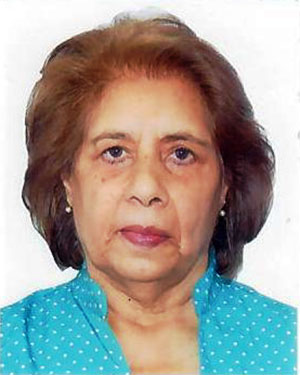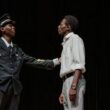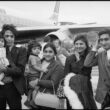
Family tribute (Summarised):
Today, as we mourn the passing on of our dear Neera, we also remember her, and celebrate her many many achievements. Neera spent her life caring and giving. This she did as a teacher in the Department of Adult Education in the University of Nairobi. The ground-breaking book of history she wrote called Race, Rail and Society was hailed by Prof. Ngugi wa Thiongo, as ‘a resource document for scholars of history and politics – of economics and culture’. She played an active role in Kenya’s constitutional reform at the Bomas and in the creation of the Asian African Heritage Exhibition. She was also active in giving her time and effort to the projects of the Lions and Rotary Clubs.
Being a daughter of a farming family, she knew very well that you do not reap unless you sow. We take comfort with the thought that Neera’s soul has gone to be with her late husband Suresh Kapila, and daughter Ruchi who passed away 17 years ago.
Pheroze Nowrojee,
Co-Chair for the Asian African Heritage Trust:
Neera was a gifted person. The unique and most valuable Agricultural section of the original Asian African Heritage Exhibition (2000-2005) was conceived and written by her. In addition, she brought artifacts from the old family dairy to embellish the display. It was all part of her own family heritage. She came from an old Kenya family. Her great-grandfather was Sardar Inder Singh Kent who had arrived in Kenya in 1892. Her grandparents, Kehar Chand and Malvi Kent, were pioneer farmers with a farm and dairy, Punjabi Farm, at Dandora, now just outside Nairobi, at that time distant from the small capital. Her enthusiastic guidance to all visitors to the Museum helped much to the great national and international success of the Exhibition. Another of her responses to the Exhibition was her book Race, Rail and Society: Roots of Modern Kenya ((Nairobi, Kenway Publications/ E.A. Educational Publishers, 2009). Of her book, Kenya’s pre-eminent writer, Ngugi wa Thiong’o, wrote: ‘The general reader will find Race, Rail and Society most enjoyable. … [It] should also prove a resource document for scholars of history, politics and all those interested in the intersection of economics, class, race, politics and culture.’ (2009). She had yet much to give.
Neera Kapur-Dromson and Dr Norman Aselmeyer:
I had known Neera Kapila since many years as we met often at the Arya Samaj where she and her husband Suresh were fervent members. Moreover, her mother and mine were close friends, belonging to the same kitty party group of ladies who met often at each others house to have lunch and enjoy a meal together. She taught at the State House Girls School, and my sister had her as a teacher.
For Neera, it was a surprise that no one had yet investigated the role of South Asians in the construction of the Kenya-Uganda Railway. She dreamed of filling this gap and bearing witness to the people whose sweat and lives were closely linked to the iron horse. After many years of dedicated research, she has accomplished a work that will be vividly remembered for generations. In her book Race, Rail & Society, published by Kenway Publications in 2009, Neera goes beyond anything written about the railways in Kenya before. She visited and worked in archives on three continents, unearthed and unveiled previously unheard voices, and collected photographs that brought the story to life. There were detailed statistics about the Indian workers, how much they were paid per day, how many hours they worked, what kinds of meals and ration was supplied to them, their clothing, bedding, the water supplies. Her book immediately became the main reference point for scholars and interested readers around the world who shared her interest in colonial railways. But her contribution went beyond that. Ngugi wa Thiong’o once stated that ‘the railway was the most important event in the modern history of Kenya’. Neera’s book lives up to this claim. It not only gave South Asian railway workers a long-desired and admirably written history, but also made her a biographer of modern Kenya.
Sultan Somjee:
Curator the Asian African Heritage Exhibition:
I came to know Neera Kent Kapila during the making of the Asian African Heritage Exhibition (1994-2000), and at once liked her for her commitment. She was my assistant curator. Neera cared for the heritage, and at once volunteered to store the entire Exhibition in the garage at her home for several years while the museum was being renovated. These are two anecdotes from the friendship we developed and the stories we shared:
The one I still laugh over was about the Kent dairy farm in upcountry White Highlands. Her father was able to purchase the land because his surname was Kent. When the neighbours saw the Kent family settling on the farm wearing shalwar kameez, they were horrified, and complained to the DC about the land being invaded by Indians. The Kents then relocated to Dandora from where their dairy farm supplied milk to old Nairobi.
The second anecdote is about Mzee Tumbo, a Mau Mau veteran, who had asked me to connect him with ‘young Kapila’. I turned to Neera to facilitate a meeting with AR Kapila who had defended the freedom fighters in the 1950s. At the meeting both AR Kapila and the veteran cried with Neera. That was the compassionate side of Neera, and her ability to connect with those who shared the freedom history.
Dr Radha Upadhyaya:
It was with immense sorrow that I learnt about the passing away of Neera Kapila. I first got to know Neera during the set up of the first Asian African Heritage Exhibition which was launched in 2000. Neera had an amazing ability to make friends and she was a key link between the exhibition and the Railways Museum. Neera was a really warm host and her and Suresh’s home became a place for many informal gatherings. I remember a particularly interesting evening with conversations with the late Binyawanga Wainaina and MG Vassanji and another one where we were introduced to the work of the Turner nominated artist Zarina Bhimji. Neera and Suresh were understandably devasted by the death of their daughter Ruchi. Neera turned her grief into a book, Race, Rail and Society which she meticulously put together. I feel very sad that because of COVID I had not met her physically for a long time. Her last email to me was on 23 March 2022 where she wrote, ‘Thank you for always remembering me in your programs. I have been unwell for some time but still trying. Thank you. Much love Neera Kapila’.
I would like to remember her like that – always trying despite all the challenges of life. Rest in Peace Neera Kapila. Om shanti shanti shanti.





